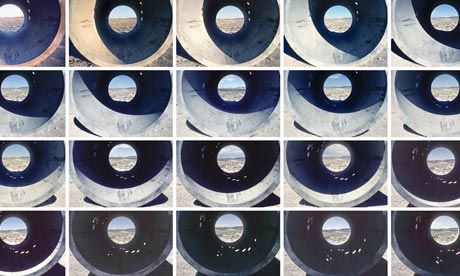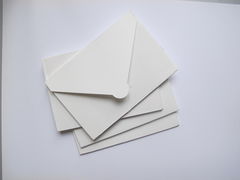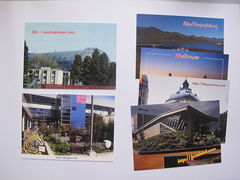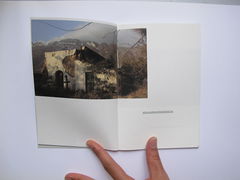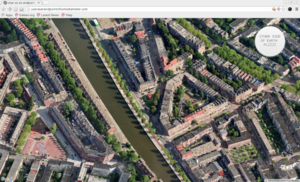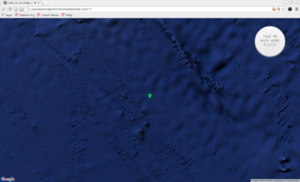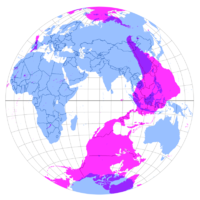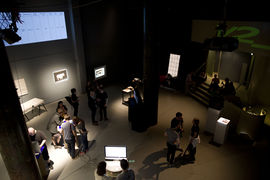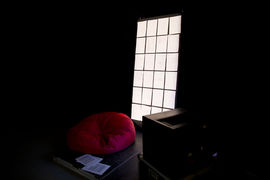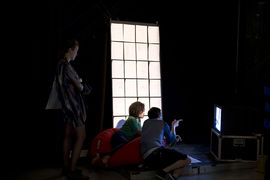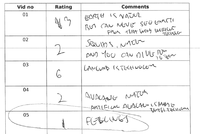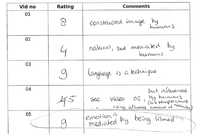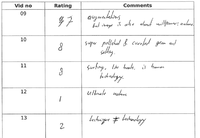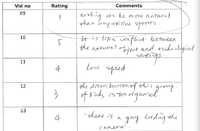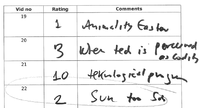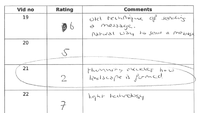User:Jules/graduationproposal
Why'd you wanna go and put stars in their eyes
Introduction
For my graduation project I want to draw constellation shapes over the world using IP addresses for points, on the basis of their geographical coordinates. Formally, this project was inspired by the Gallery Transplants made by Dennis Oppenheim in 1969. A Gallery Transplant consists in a transfer from the enclosed architectural and cultural space of the museum to an open exterior space. He applied the process to the Andrew Dickson White Museum and the Stedelijk Museum transferred respectively to the campus grounds of Cornwell University and Jersey city.
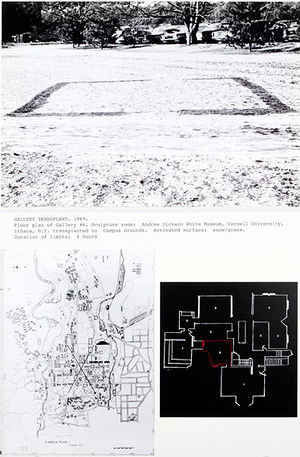
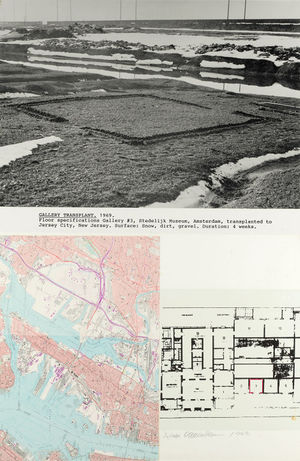
The plan of the galley's floor is drawn outside in the snow. The result is then presented with an official plan of the Gallery, a topographic map and a picture of the installation.
Robert Smithson referred to that work talking about “Dis-location” to qualify Oppenheim's process. To him Oppenheim operated in a Data transfer from a part of the world to another.[1]
This intervention will be vulnerable, because of the rapid changes over the Network and its processual nature. I will have produce documents through its realisation to testify of its conceptual existence. This would constitute the project's final outcome, since no one would be able to go on site anyway.
Thinking about the sun tunnels of Nancy Holt made me decide to go for star constellations, which is a formal analogy with computer Network topologies and a nod towards celestial navigation. [2] As an apparatus, the Sun Tunnels enables the connection between the two milieus by transferring information from one to the other.
"It’s an inversion of the sky/ground relationship-bringing the sky down to the earth."
Relation to previous practice
My previous practice is articulated around the process of mapping space and revealing invisible processes but also questioning the ways of creating such visualisations. The reflexivity on the tools is important to me because visualisations are performative and can determine our relationship to our close and distant environment. Another important thing about my work is that I never really consider my projects as formally set. They can be reactivated through different formats.
1. Browsed landscapes [3]
Browsed landscapes consists in a series of three projects like variations of the same process The different applications of the same operation can generate different highlights over the question of the place when it comes to the Internet's infrastructure outputs. The investigation was pursued over the Network with the tools I could find.
Demo on Max OS X using Google Chrome Browser
2. Userasanendpointofsomediameter [4]
With userasanenpointofsomediameter, I geolocated the user's position on Google maps and took him through a “fake tunnel” that would lead them to the antipodes of their position. Although the title suggests the World as a spherical geometrical shape, the whole process deploys itself over the flat surface of the screen. This paradox is also present within the tool used, the ubiquitous interface of Google maps is presenting to us a flattened vision of the world.
Nevertheless, within the API, I used the formula enabling to find a diameter's endpoint, in relation to any point over a circle's circumference.
var antipodes_lat = currentLatLng.lat() * -1;
var antipodes_lng = currentLatLng.lng() + 180;
3. "It reminds me of a scene in Interstellar" [5]
For the project “It reminds me if a scene in Interstellar”, I established a set of 25 videos extracts of 15 seconds each that I found on Youtube and which, to my opinion, could be ambiguous. The audio and titles were removed, to only focus on the visual content, outside its primary context. A panel of volunteers have been asked to rate the set on a scale from 1 to 10, where 1 corresponds to nature and 10 to technology. Sometimes, the volunteers explained the motivation behind the decisions they made. The average grades defined the positioning of the videos in the final montage.
The results I got were extremely variable from one person to another, underlining the difficult aspect of drawing a line between the two notions. The mental representation we have of what is natural and what is technological can conflict with the actual traces of human involvement to generate those representations.
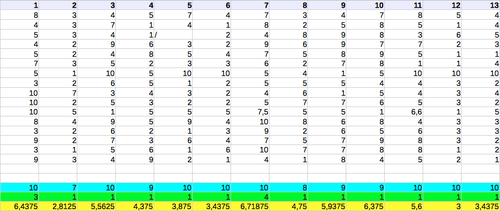
Cyan is the highest score (technology)
Green is the smallest (nature)
Yellow is the average (final position)
I asked for names and biographies because I thought that it would directly relate to the subjectivity in answers provided (a graphic designer and a nurse may not share the same view over what nature may look like, due to their education and activities)
I also specified that I wanted the sheets to be filled by hand to keep the trace of human labour involved.
Thesis intention and sort of Abstract for the context
I would like the thesis to reflect on my process. Making an installation within a networked environment necessitates to be mediated by means for spatial representation. Since the tools for mediation plays a major part within the work, I will reflect on their implications and functioning. By doing so, they tell the story of the intentions of their creators and propagators. I think it will be also important to define what it means to locate and mediate physical locations through Digital Networks. Investigating the spatial properties of the Internet determine our relation to society and reflexively opens the reflection on what in means to inhabit space in the era of ubiquitous computer Networks.
Context
“Our culture is undergoing a truly drastic change in terms of our physical and psychological relationship with space and other bodies.”
-Machiko Kusahara [6]
These are a few topics Environmental Art brought up to my mind. I feel that I can relate them to my practice and readings.
1. Entropy
"The future is but the obsolete in reverse"
-Vladimir Nabokov [7]
[…] it's (entropy) a condition that's irreversible, it's condition that's moving towards a gradual equilibrium and it's suggested in many ways.
-Robert Smithson[8]
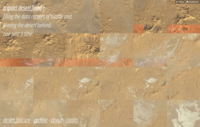
Following the logic described by Smithson's drawings about the Earth works, my site installation will perish, because of changes in the Network. This equilibrium mentioned by Smithson is nested within the continuity experienced by users while browsing experience of the Internet, as discussed by Alexander R. Galloway.[9] Continuity is enhanced thanks to a strict set of rules which aims to ban any trace of obsolescence from the user's experience (link rot, obsolete machines, etc). The failure to maintain the work on a long time scale which is to be expected can reveal the rapid change in agencies within digital Networks. It is also an act of resistance against the sensation of smooth continuity enhanced by protocols. The functioning of the most powerful infrastructure supporting our lives are invisible until they let us down. This notion is also present in the recently unveiled A quiet desert failure[10] by Guido Segni which automates the transfer of Google's satellite images from the Sahara desert to Tumblr's data servers. The page mentions that “The whole performance will approximately take 50 years to be completed, but it is still not clear if the audience, the Google’s servers, the tumblr archive or the Internet itself will last enough to see the end.”
Drawing a static shape over the Internet would constitute an event that will become quickly impossible to reenact.
Practical steps
At the moment, I am getting more familiar with the tools. I am using a MongoDB version of the MaxMind GeoIP legacy database. I have exported some json files compiling all the relevant data on Latitude and Longitude criteria. I need to make more complex requests soon, such as precise geometrical shapes, and start experimenting with the plotting. I may start visualising the locations with Google Maps for a first draft but I would like to be able to cross with other types of maps.
After Christmas, I will work on using IP addresses extracted on the basis of Geographic criteria to find websites, so I could spatially recontextualise information and location.
Then I will be able to work on prototypes showing information alongside location.
Regarding the documentation of my working process, I will try to build on the things I have developed over the last year.
Firstly, I have adapted the interface of a very simple cms which I can update it from my computer over my server thanks to Git. It functions as a notebook which helps me keep a trace of what I have been reading. It is quite flexible and I try to add pads next to my notes in case I ever want to cross references.
→ http://pzi.here-you-are.com/notebook/ .
I have prepared the same system to have a set of images I can refer to (although I have been very bad at updating it so far).
→ http://pzi.here-you-are.com/imgdir/
Sometimes, when investigating a specific topic, I also write a text as it helps me assimilate information that I have been gathering and and associate facts together. This practice often goes alongside making practical sketching experiments such as the following ones :
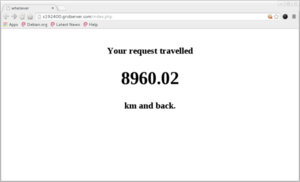
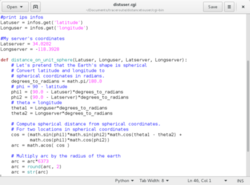
https://pzwiki.wdka.nl/mediadesign/User:Jules/opticsofdatatransmission
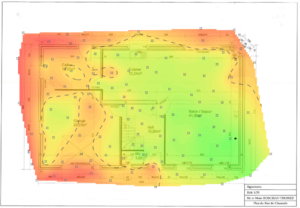
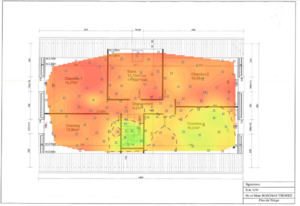
https://pzwiki.wdka.nl/mediadesign/User:Jules/wifiheatmap
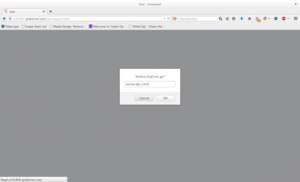
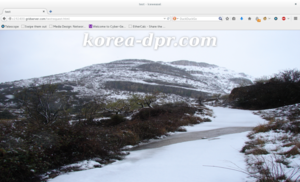
http://pzwiki.wdka.nl/mediadesign/User:Jules/geoipdatabases
References
For actual set of references, or just things that trigger my interest, please see:
http://pzi.here-you-are.com/notebook/
The notebook contains etherpads on which anyone can add thoughts or references they feel like doing such
http://pzi.here-you-are.com/imgdir/
And this is a little list of things I need to investigate soon :
- Simulacra and simulation, 1994, Baudrillard
Today abstraction is no longer that of the map, the double, the mirror, or the concept. Simulation is no longer that of a territory, a referential being or substance. It is the generation by models of a real without origin or reality: A hyperreal. The territory no longer precedes the map, nor does it survive it. It is nevertheless the map that precedes the territory - precession of simulacra - that engenders the territory.
- Steps to an ecology of the mind, 1972 Gregory Bateson:
We say the map is different from the territory. But what is the territory? Operationally, somebody went out with a retina or a measuring stick and made representations which were then put on paper. What is on the paper map is a representation of what was in the retinal representation of the man who made the map; and as you push the question back, what you find is an infinite regress, an infinite series of maps. The territory never gets in at all. The territory is Ding an sich and you can't do anything with it. Always, the process of representation will filter it out so that the mental world is only maps of maps, ad infinitum.
- From Psychogeography to Cybertopology; 2006, Sher Doruff
(dis)Orienting Place : Performing “ place” through purposeful disorientation was the aesthetic of early Situationist dérives. Today the technological accoutrement for triangulated, coordinate spe-cific, Cartesian orientation is apparent in many current locative projects. Aesthetic practice accessed through a network of military satellites has détourned the dérive signifi-cantly. The shapeshift between discipline and control, between game and play, is felt in the relation between orientation and disorientation.
- Smooth and striated space, 1972, A thousand plateaux
- Entropy made visible, 1973, Robert Smithson
De-architecture : Architects never seem to allow for any kind of relationship outside their own plans, same with economics. They expect to be isolated and self-contained, conceived as cycles to exclude the entropic process.
- GPS Errors and Pilgrimage to Lourde, 2010, Benjamin Mako Hill
http://revealingerrors.com/lourdes_gps
———??? “Architecture is an art of distinctions within the continuum of space.” (W.J. Mitchell, The Logic of Architecture, p.1)
- ↑ (1)Lisa Bear et Willoughby Sharp, "Discussions with Heizer, Oppenheim, Smithson (1970)", In : Robert Smithson : The Collected Writings, Berkeley, Los Angeles, London, University of California Press, 1996, p. 244.
- ↑ https://pzwiki.wdka.nl/mediadesign/User:Jules/linkingdots
- ↑ http://pzwiki.wdka.nl/mediadesign/User:Jules/browsedlandscapes
- ↑ http://userasanendpointofsomediameter.com/
- ↑ http://pzwiki.wdka.nl/mediadesign/User:Jules/remindsmeofinterstellar
- ↑ “Presence, Absence, and Knowledge in Telerobotic Art,” in The Robot in the Garden, 2000
- ↑ "Lance", 1952
- ↑ "Entropy made visible", 1973
- ↑ "Protocols or how control exists after decentralization", 2004, p 68
“All technology is new technology. Everything else must be eliminated. Dead media are those media that have fallen out of use. They include everything from dead hardware (Commodore 64, Apple II) to dead computer languages (Fortran, Cobol) to dead media formats (Sony Betamax, 8-track cassette). Dead media means discontinuity. Dead media do not function within contemporary network flows; therefore, they have no place.” - ↑ http://desert.fail/ure/

